From the fourth grade through high school, I played baseball and ran sprints in track. Sacramento was a baseball town in those days. I played center field. I could have signed up to play pro baseball, but I had also been accepted to attend Caltech, MIT, and Reed College. I chose to attend Caltech.
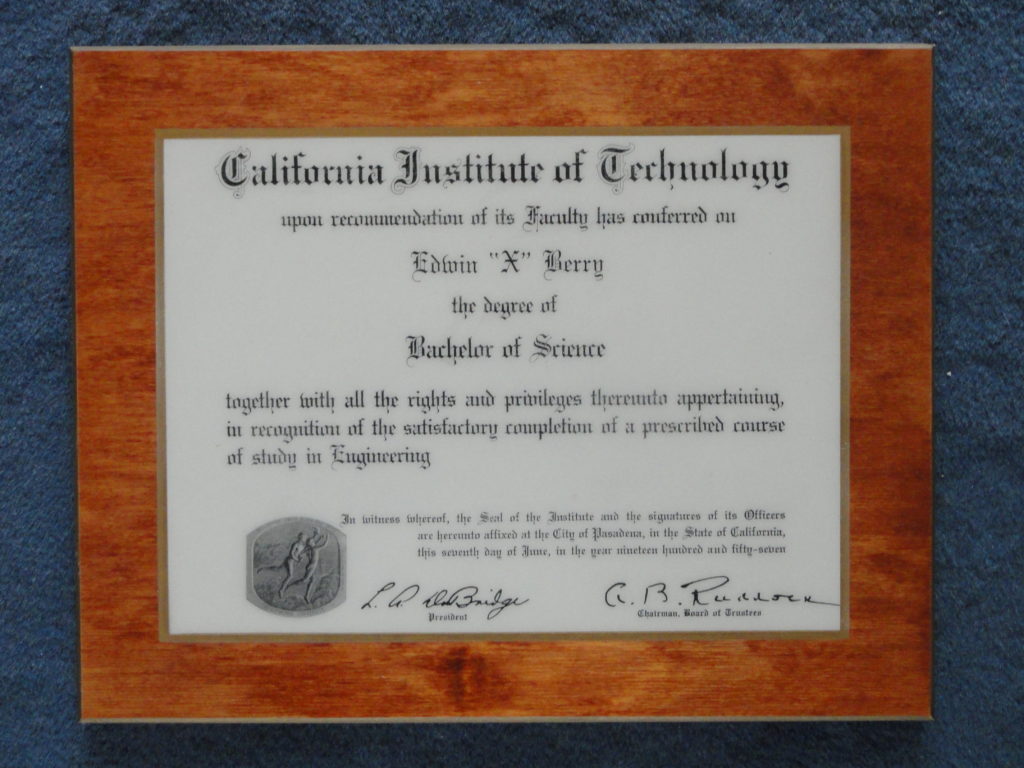
At Caltech, I was in the AFROTC as a pilot trainee. I looked forward to flying. However, in the last week before graduation in 1957, the Air Force Officer told our pilot class that Congress had reduced the quota for pilots. Therefore, we were not all going to be pilots. So, he said, we can either draw straws to see who flies a jet and who flies a desk, or we could take an Honorable Discharge. I did not like the odds of flying a desk, so I took the Honorable Discharge.
Although I could not see my future, this Honorable Discharge opened the opportunity for me to become a teaching fellow in physics at Dartmouth College, and it helped Gordon Fullerton, who was in our AFROTC class, become an Air Force pilot who would go on to fly space shuttles.
After graduating from Caltech, I spent summer evenings in Ed Parker’s very first Kenpo Karate class with his “gang-of-eight” in Altadena. Ed Parker gave us very intensive training in Kenpo Karate and taught us things he apparently did not teach his future classes. (Ed Parker on the right. Unkown on the left.)
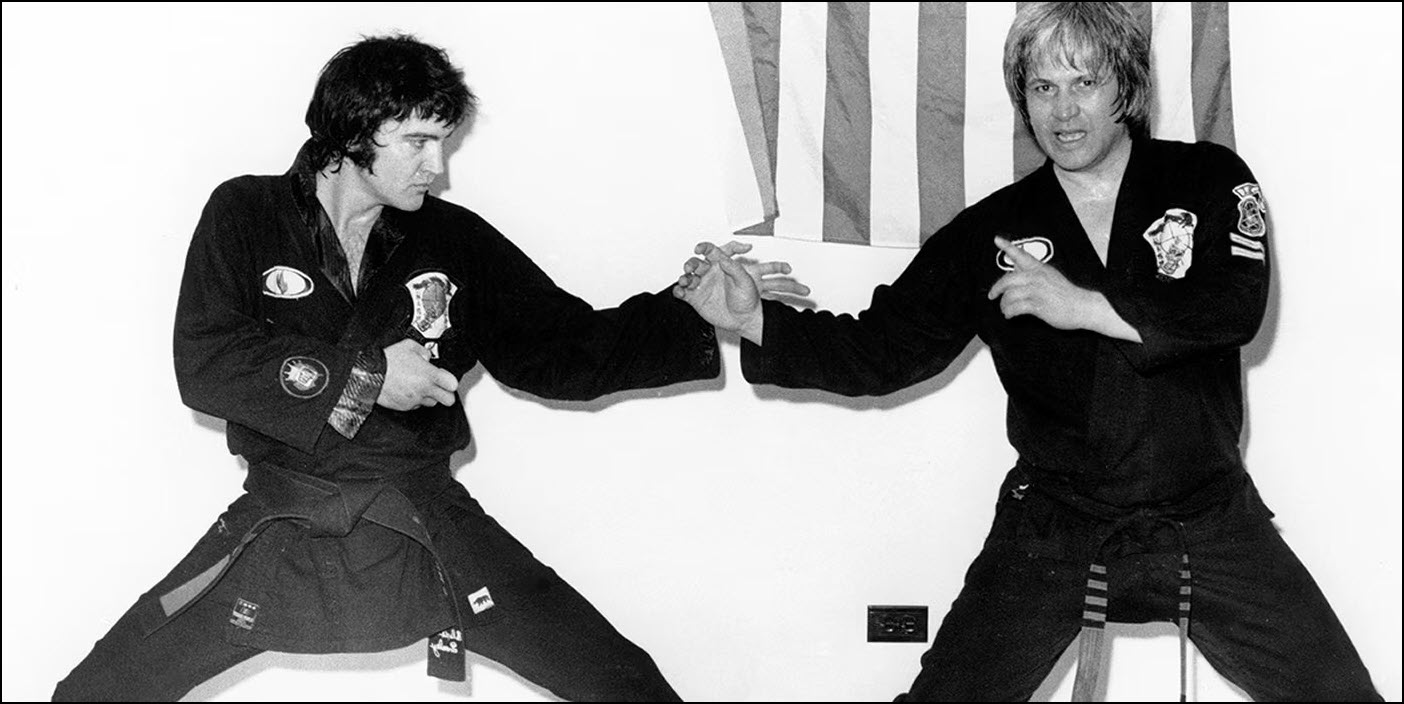
Strange as it may seem, I found the most valuable part of his class was in learning how to fall. This training prevented me being seriously hurt in two unexpected falls. Once I parked a U-Haul truck on an upward slope at a gas station. I wanted to check inside, so I stood on the rear bumper while holding the door handle to keep from falling backwards. The handle pulled out of the door and left me to fall backward onto concrete that was six feet below where I was standing. I reacted instinctively and landed perfectly on my back without any injury. Years later, I was riding my bike at the U of Nevada when the front wheel suddenly stopped (because someone stuck an object into the spokes). In one second, I flipped over the handlebars and landed on my back. Instinctively, I landed perfectly without injury.
At the end of the summer in Altadena, I moved to Sacramento where I taught physics at Sacramento State University. One day, an announcement on the bulletin board said Dartmouth College was offering six teaching fellowships in physics . I applied and was one of the chosen six. That was a key turning point in my professional life.
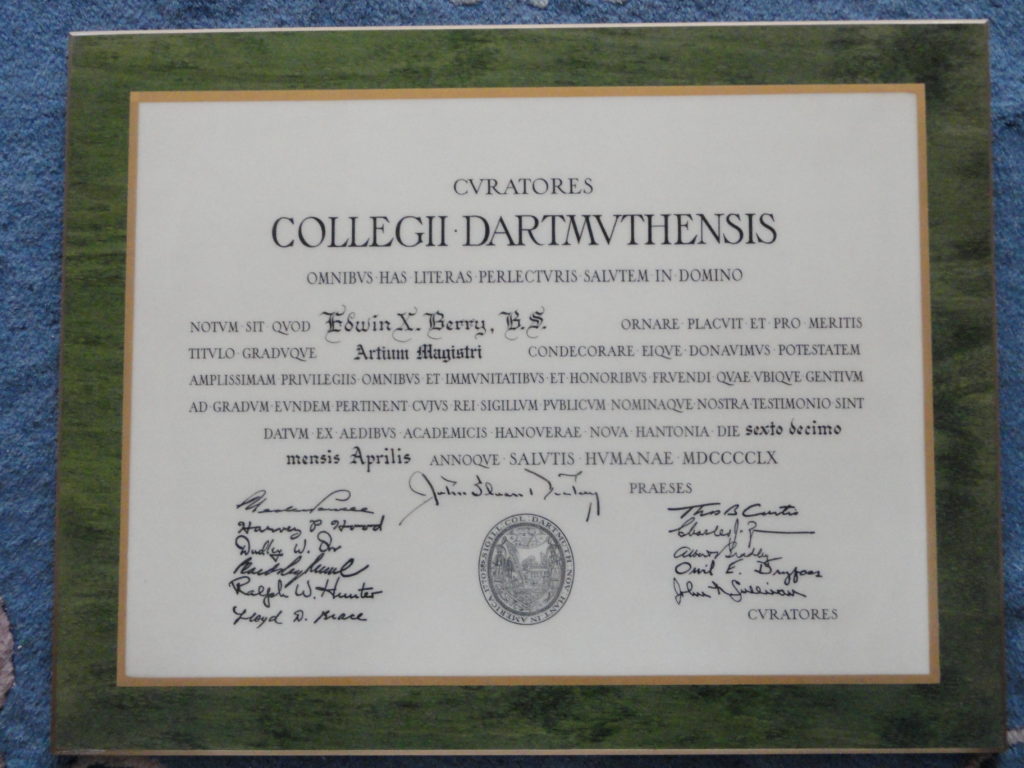
My master’s thesis at Dartmouth was in atmospheric physics. After Dartmouth, the University of Nevada at Reno offered me a research fellowship so I could work on my PhD in physics.
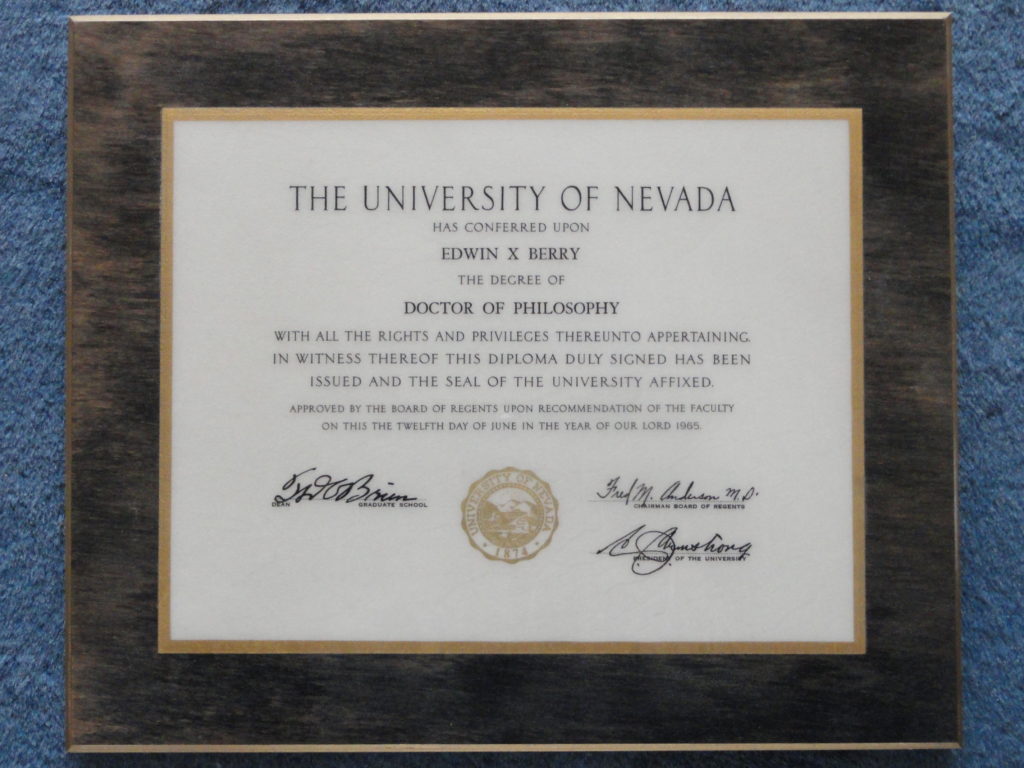
Sigma Delta Psi National Athletic Honarary
While a graduate student at the University of Nevada, I worked out with the university gymnastics and trampoline team. Coach Art Broten invited me to perform events in track, gymnastics, and swimming to qualify for membership in the elite Sigma Delta Psi national athletic honorary. It is not an easy challenge because it requires a wide range of athletic ability. Very few have achieved the required level of all-around athletic performance. Sigma Delta Psi members include Astronaut Ed White, Dr. Hatfield, super-athlete Norm Hoffman, Harvey Wray, Dr. Robert Gordon, Scott Hurley, Bill Ruschel, and Thomas Cureton.
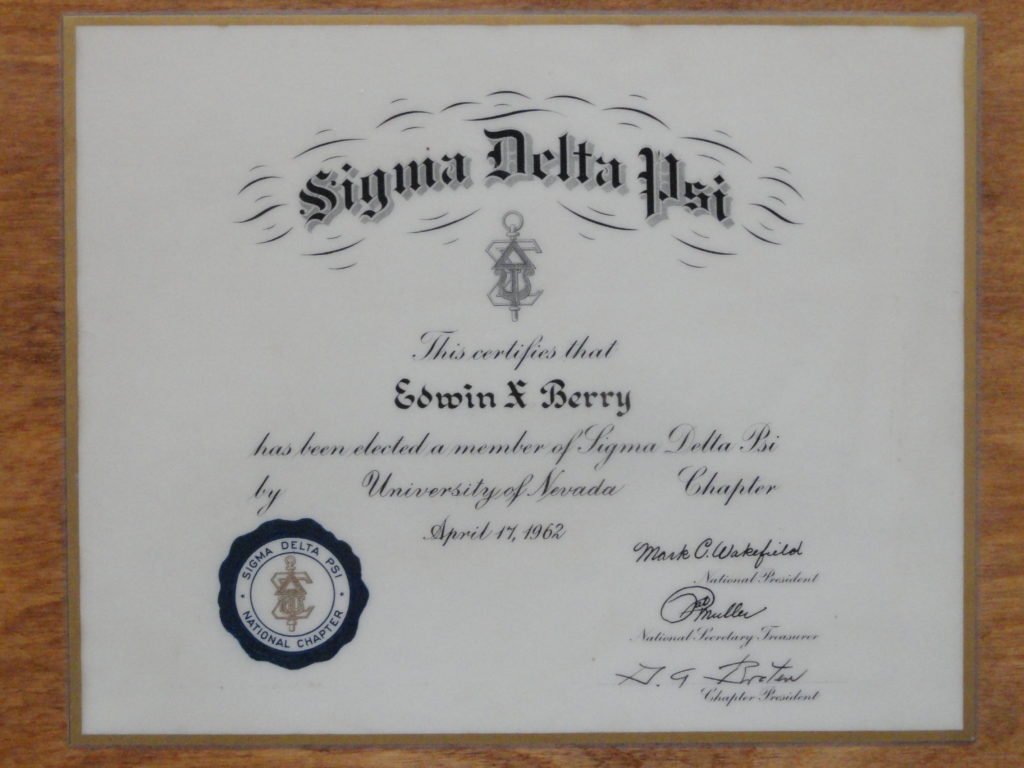
Soaring
While a graduate student, I learned to fly sailplanes under instructor Ed Blaylock with the Reno soaring club. We flew off Nevada’s dry lakes using an old Buick and a 2000 ft long steel cable to tow the sailplanes to 1200 feet above the dry lake. That way a tow cost us only $1.00.
At 1200 ft above ground, it was easy to catch strong thermals and soar for hours. Once I caught a strong thermal that gave a 4000 ft/minute upward ride to 16,000 ft ASL. At that altitude, I purposely exited the thermal because I did not have oxygen.
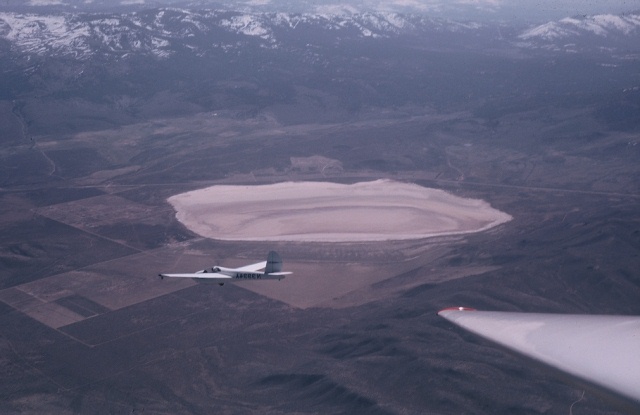
That’s me flying the blue sailplane. In the distance is the dry lake where the club members took off and landed. Once, when I was soaring at 10,000 ft, an eagle soared just above my left-wing. To the eagle, I was just another bird.
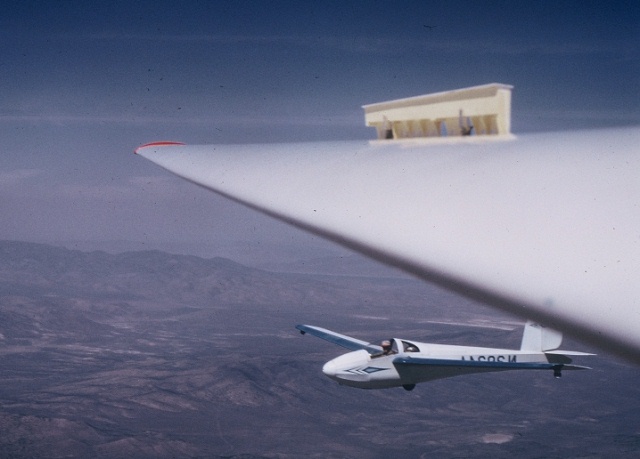
While in a very strong updraft, I got “sucked up” into a developing thunderstorm. It was like someone dropped a blanket over the canopy. The sailplane had no gyro instrument which is necessary to keep an aircraft properly oriented when you cannot see outside. This is a dangerous situation because one will enter a death spiral from which there is no exit. So, I did the only safe maneuver. I stalled the sailplane and put it into a spin, then waited until I dropped through the bottom of the thunderstorm and watched the earth spinning around. I spun for a good 1000 feet to get below the very strong updraft before recovering from the spin.
Time to go home but as I set up to land heading west, a dust storm approached rapidly from the west. The dust engulfed my sailplane while I was still about 100 feet above the dry lake bed. So, I kept everything steady and waited until the wheel touched the dry lake. My first and only zero-zero landing. Once on the ground, the wind was so strong, I had to “fly” the sailplane on the ground to keep it from blowing away. About 15 minutes later, headlights of vehicles appeared slowly coming my way. These were the other sailplane pilots who had observed my predicament and were hoping to find me and the club sailplane in one piece.
Private Pilot, Instrument License
When I became chief scientist for the Desert Research Institute aircraft research facility, I took power flight lessons from Tom Wells, DRI’s chief pilot. Later, I got my instrument license. Tom Wells took this photo of me in Gerlach, Nevada, on my first cross-country flight.
Sailing Championships
While at the Desert Research Institute in Reno, I took up small boat sailing in the nearby lakes. Sailing challenged my meteorological skill and athletic ability. My wife, Valerie, an excellent swimmer, was my crew.
Below is our sailboat of many years ago. The Fireball is 16.5 ft long, 220 pounds. With a centerboard and spinnaker, it was a very competitive international class sailboat. This was a beautiful boat: built in England, stiff, and perfectly balanced.
Here Valerie and I are preparing for a race. We have installed the spinnaker in its tube. Valerie is hooking up the jib. The Fireball is like a sports car, and it will easily beat the larger boat in the background. Notice the trapeze handles.
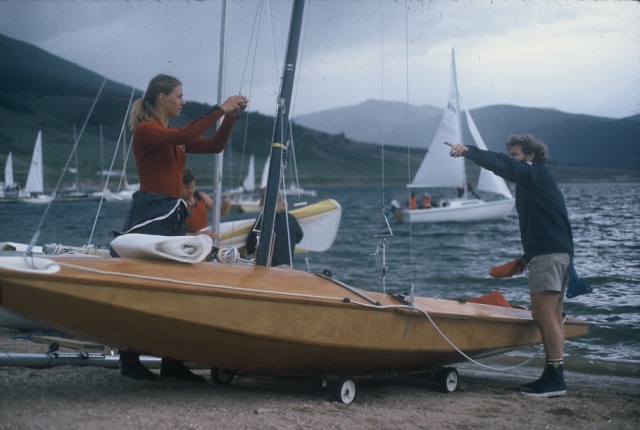
A prerequisite to winning in tough competition is to not be afraid to go swimming. When you pop the chute in a 20-knot wind in a small boat like this you are sailing on the edge. If you are not willing and able to sail on the edge you will lose to those who do. If you are afraid to go swimming, you will sail too defensively, and chances are you will go swimming. Valerie was good at high-performance centerboard sailing because she is an excellent swimmer and athlete, and she was never afraid even in the most extreme winds and waves. Once I took a macho motorboat guy for a ride on our Fireball in a 20-knot wind. Afterward, the motorboat guy said it was the first time he had ever been scared on water.
The clouds give away the direction. It is a west wind aloft and a southwest wind on the lake. The view is to the south and the shadows show it is about 2 PM. The location is a lake between Reno and Carson City in Nevada.
We entered the US National Championship in Austin, Texas, in 1975. The word was only local sailors can win because it takes years to understand the complicated wind on this lake. We arrived in Austin a few days before the race series. I stopped at the National Weather Service office to discuss the local weather with the lead meteorologist. Then we sailed the lake for two days to observe how the wind came over the hills and down to the lake.
We are in US 7485 just after a start in the Fireball National Championship in Austin, Texas. Valerie is on the trapeze. We have an excellent start, a clear wind, and very tough competitors. We won this race and enough other races in this series to win the National Championship. Yes, I do actually “see” the wind during a race. It helps having studied fluid mechanics as part of my PhD in physics.
We became Pacific Coast champions, National champions, and North American champions. In the premier event of all, the Canadian Olympic Regatta in Kingston (CORK), Ontario, we won Gold Medals. We beat Olympic competitors and Valerie became the first woman to win in such high-caliber sailing competition.
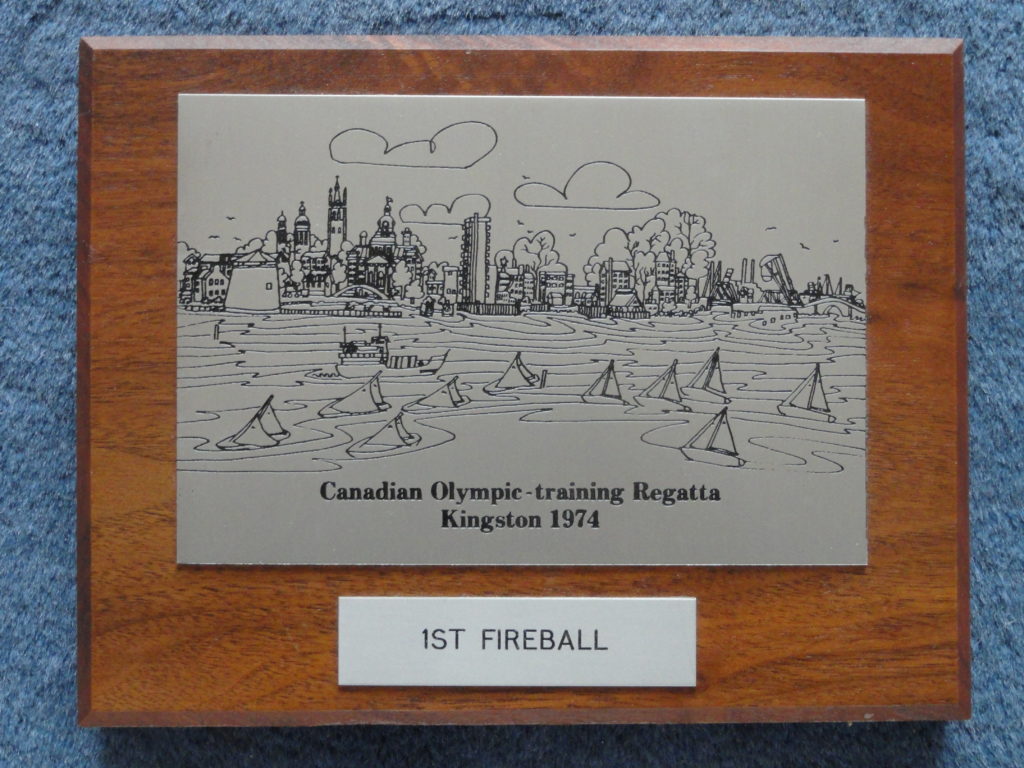
If you are going to win a national or world championship in a small centerboard sailboat, you must sail on the ragged edge in strong winds. If you chicken out, someone else will beat you. The best of the European sailors were there. The only way to win such races is to go “balls out” all the way and try to not make any mistakes.
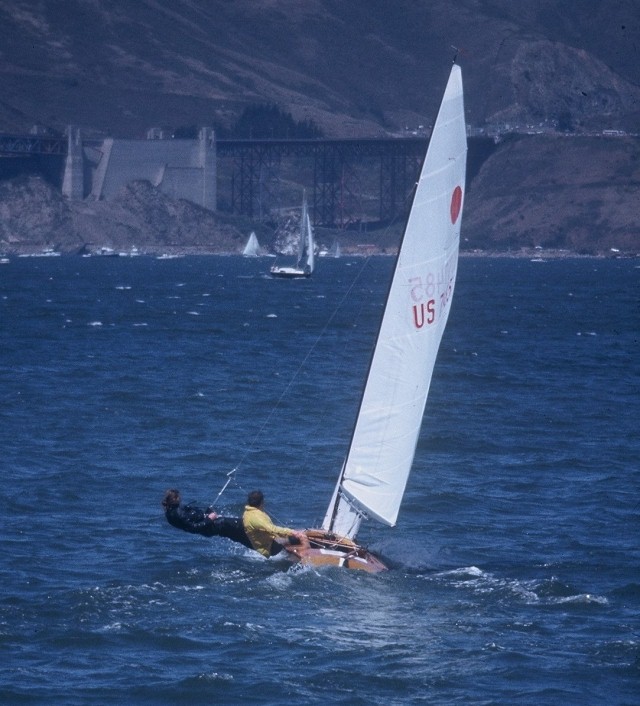
Here’s a photo of us taken from San Francisco’s St. Francis Yacht Club. This is the last leg of a race and we are more than 1/4 mile ahead of the fleet. How did this happen when the boats vary in speed by only a few percent?
It happened because I saw a small change in the wave pattern near the center of the bay that indicated the tide was shifting from ebb to flow. So I departed from the fleet tacking near the shore and sailed toward the middle of the bay. Our competitors told me after the race that they thought I had lost it. But when we entered the westward-moving tide, we picked up 5 knots westward over the rest of the fleet, as I predicted. Even on the second lap, our competitors did not catch on to how we used the tide change.
When the tide changes in the San Francisco Bay, it does not change everywhere at once. The new tide develops near the center of the Bay and then gradually expands to cover the whole Bay. I saw the evidence of a new tide near the center of the bay. My competitors saw only the tide near the shore where they were sailing. It was the biggest “horizon job” we ever did on a fleet of expert sailors.
Running, Duathlons, and Triathlons
After we moved to Sacramento, we did more running than sailing. I won several local 5 K races and placed in the USA Top-10 in a four-weekend Duathlon of 5 K run, 25 K bike, 5 K run.
In 2002, the Pan Pacific Masters Games came to Sacramento. I ran the 200 m, 400 m, 800 m, 1500 m and 5 K, and finished in the top three in all events. In 2005, we went to the US Masters Nationals in Hawaii, I ran in the 200 m, 400 m, 800 m and 1500 m and placed in the top three in all events.
Special thanks to Coach Mike Reid, American River College, Sacramento
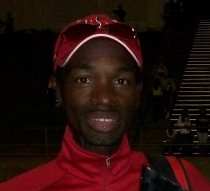
At the beginning of the 2006 college track season, Coach Mike Reid (track coach for American River College in Sacramento) invited me to work out with his track team.
In March 2007, we went to an all-comers track meet at the University of California, Berkeley. Coach Mike suggested I focus on the 400 and not run the 200.
Since there was no one else my age, the race committee put me in the 400-meter race with the best high-school track teams. They assigned me the inside (#1) lane. The starting gun fired and we were off and the high school dudes disappeared in the distance. Their speed “sucked” me along as I tried to keep up. They were finishing their 400 as I entered the straightaway for my final 100 meters.
Just as I was asking myself, “What am I doing in this race?”, the crowd in the stands saw me struggling to finish. It did not matter that I was the last dude in the race, or even that I was a white guy with a mostly black audience. They cheered me on and this made me run faster. I almost fell down as I crossed the finish line.
After I recovered enough to walk around, we checked my time with the race committee. They clocked me at 67 seconds which is a few seconds off the US National record for the 70-74 age group.
The moral of this story is even if I had tied the National record, I still would have finished last. And that is putting it politely. The high school dudes had enough time to drink a glass of milk, eat a sandwich, call their mother, and interview on TV before I crossed the finish line. The moral is if you are 71 years old, forget about beating your high school track team. It’s impossible.
Flying an L-29 Jet
In May 2004, I tested my pilot skills in a Russian L-29 jet. The instructor put me in the front seat and gave me the controls right after take off.
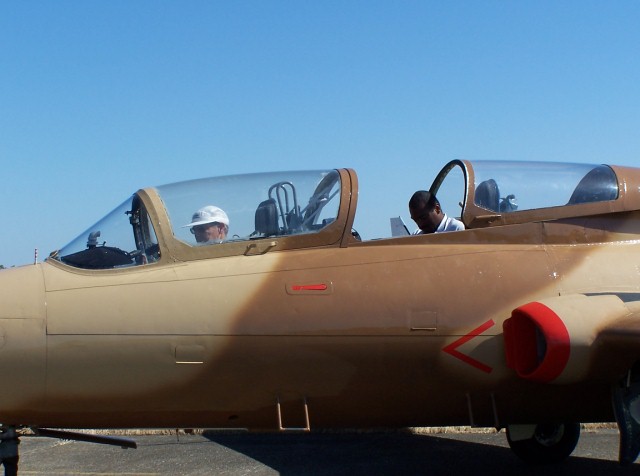
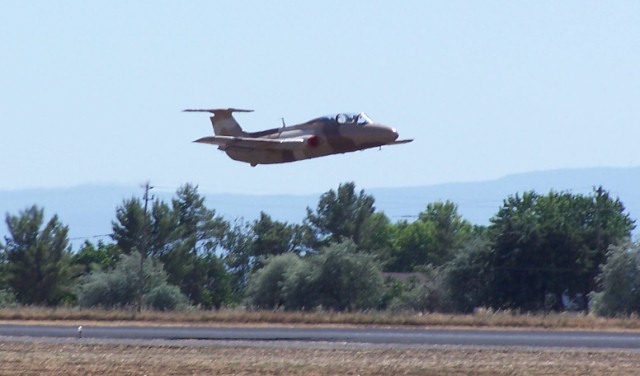
I told the instructor the jet responded to the stick just like a sailplane I flew many years ago. After putting 5000 feet between us and the ground, I did very tight turns (over 60 degrees bank), keeping altitude, rolling out on headings I pre-designated. I did multiple rolls and loops.
On the way back home, my instructor said, “I have never done this before on someone’s first ride but you flew so well I am going to let you land it.” I landed the L-29 with no problem.
Moved to Montana
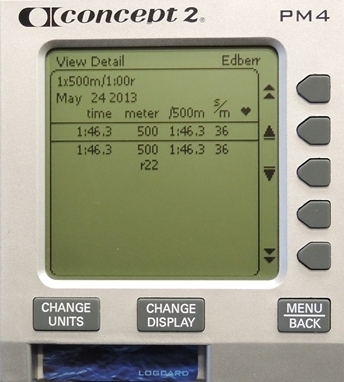
We moved to Montana in 2008 and began a new life in a home on ten acres, 2 miles north of Flathead Lake. I mowed a 400-meter “summer” track in our backyard.
In 2013, we found a gym in Bigfork with a Concept 2 rower. After three months of workouts, and one month short of age 78, I rowed 500 meters on a Concept 2 in 1:46.3 to earn a 2014 world fourth place in the 70-79 age group, and second place in the world lightweight division.
Four years later, on March 21, 2018: I rowed 500 meters in 1:41.5. That put me only 0.4 seconds behind the world record of 1:41.1 set by Dean Smith in 2008.
The Concept 2 rower is the best exercise machine in a gym. It uses all your major muscles. It lets you max out in speed, strength and endurance. It’s safe and fun. If you haven’t rowed a Concept 2 rower, you should try it.
I combine a knowledge of physics with a lifetime of athletic performance. I have thoroughly analyzed the physics of rowing a Concept 2 rower. I can help you to improve your fitness with rowing and achieve your maximum potential in competitive rowing.
So now, you know a little about my history.
We enjoy living in Bigfork, Montana. Best move we ever made.
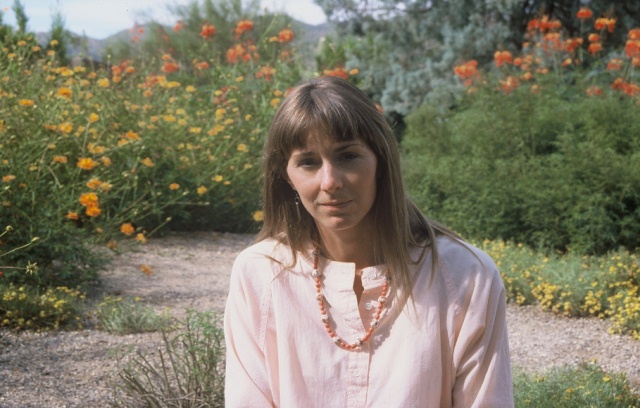
I love Valerie.
